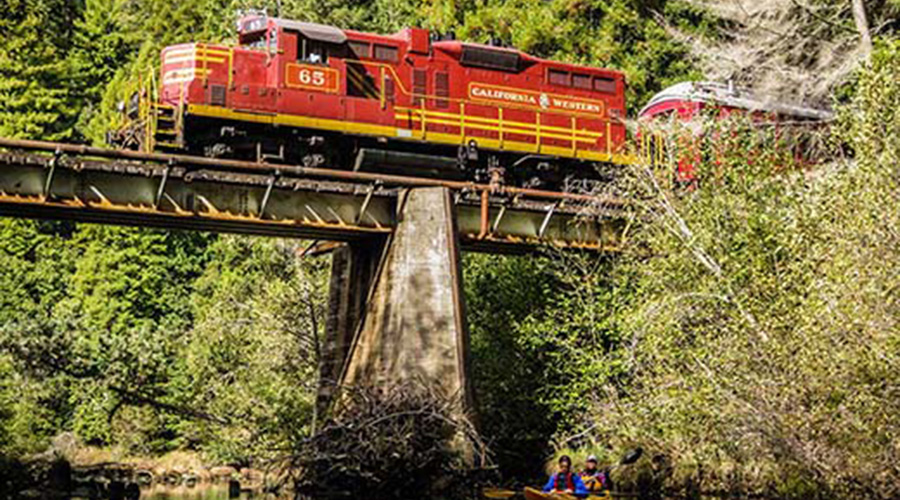California short line turns 20, preps for major infrastructure project
5/21/2024
By Jeff Stagl, Managing Editor
May is a big month for the Mendocino Railway. The short line marked its 20th anniversary on May 1 and expects to begin a more than $20 million, multiyear infrastructure improvement project on May 28.
A Sierra Railroad Co. subsidiary that controls assets known for many decades as the California Western Railroad and the Skunk Train, Mendocino Railway provides freight- and passenger-rail services along 40 miles of track between Fort Bragg and Willits, California. The short line was established in 1885 as the Fort Bragg Railroad by the Fort Bragg Redwood Co. to move redwood logs from forests to a new lumber mill near Fort Bragg.
In May 2004, Mendocino Railway acquired the assets of the California Western Railroad and Skunk Train through a bankruptcy proceeding to preserve freight- and passenger-rail service in the Mendocino County area. The railway now also operates the Sacramento RiverTrain/River Fox Train along the banks of the Sacramento River through Yolo County. Last year, the short line launched operations on a Santa Paula branch line in Ventura County.
The transformation of the short line over the past two decades stands as a testament to perseverance and dedication, said Mendocino Railway President Robert Jason Pinoli in an email.
“It’s a journey that showcases the remarkable spirit of our team and the enduring legacy of the railroad,” he said.
Now, the short line is about to embark on a new expedition that involves extensive infrastructure restoration and rehabilitation work. In January, the Mendocino Railway learned it would obtain a $21 million Railroad Rehabilitation & Improvement Financing (RRIF) loan from the U.S. Department of Transportation’s Build America Bureau to help fund improvements to a Noyo Canyon tunnel, 27 bridges, 40 miles of track and several sidings.
 The short line will obtain a $21 million Railroad Rehabilitation & Improvement Financing (RRIF) loan from the U.S. Department of Transportation’s Build America Bureau. U.S. Department of Transportation
The short line will obtain a $21 million Railroad Rehabilitation & Improvement Financing (RRIF) loan from the U.S. Department of Transportation’s Build America Bureau. U.S. Department of TransportationAlthough the RRIF program was originally created in 1998, the current program was established by the Transportation Equity Act for the 21st Century. It also was amended by the Safe Accountable, Flexible and Efficient Transportation Equity Act: A Legacy for Users, Rail Safety Improvement Act of 2008, and the Fixing America’s Surface Transportation Act.
The program provides direct loans and loan guarantees up to $35 billion — including $7 billion set aside for regionals and short lines — to acquire, improve or rehab intermodal or rail equipment or facilities; develop or establish new intermodal or railroad facilities; refinance outstanding debt; or fund transit-oriented development projects.
Mendocino Railway expects tunnel restoration work to start in late May. The tunnel improvements will be completed in 2025, with the balance of work in the project to be done over a five-year period, said Pinoli.
The RRIF loan brings the railroad’s combined infrastructure investments to more than $50 million since 2004.
“This is a crucial step toward ensuring that the railroad remains capable of providing passenger- and freight-rail service to our communities for years to come,” said Pinoli.
But that step forward took a long time to come to fruition. The process to secure a RRIF loan began nearly four years ago and there were several hiccups while awaiting Build America Bureau approval, said Pinoli.
Some delays were caused by environmental concerns raised by the city of Fort Bragg and California Coastal Commission. However, the Federal Railroad Administration completed a thorough and comprehensive environmental review of the project, fulfilling its National Environmental Policy Act responsibility, Mendocino Railway officials say.
Non-federal agencies seeking to assert their authority over a federally regulated railroad posed quite a challenge to the project, said Pinoli.
“The physical work in the tunnel, and the replacement of ties, rail and other tasks as called out in scope of work is the easy part,” he said.
The encouraging news is the Mendocino Railway now has taken rail lines on the brink of closure to the edge of new milestones, Pinoli stresses.
“This journey symbolizes the strength of Mendocino Railway’s vision and the unwavering support of its staff, visitors and supporters,” he said.


